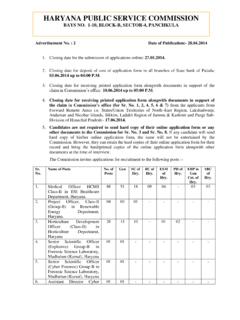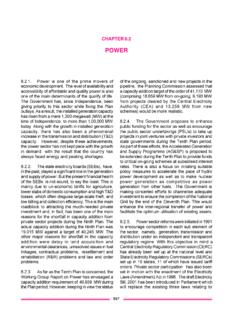Transcription of INDIA SOLAR HANDBOOK 2017 - BRIDGE TO INDIA
1 1 BRIDGE TO INDIA , 2017 BRIDGE TO INDIA , 2017 Illustration by tiffinboxINDIA SOLARHANDBOOK2017 Including theINDIA SOLARCEO SURVEYLead sponsorAssociate sponsor5 BRIDGE TO INDIA , 20176 BRIDGE TO INDIA , 2017 Disclaimer 2017 BRIDGE TO INDIA Energy Private LimitedAll rights reserved May 2017 , New DelhiNo part of this report may be used or reproduced in any manner or in any form or by any means without mentioning its original TO INDIA is not herein engaged in rendering professional advice and services to you. BRIDGE TO INDIA makes no warranties, expressed or implied, as to the ownership, accuracy, or adequacy of the content of this report. BRIDGE TO INDIA shall not be liable for any indirect, incidental, consequential, or punitive damages or for lost revenues or profits, whether or not advised of the possibility of such damages or losses and regardless of the theory of further enquiries, please TO INDIA Energy Private LimitedC - 8/5, DLF Phase I,Gurgaon to our weekly mailer our blog for up-to-date market insights and the Indian SOLAR market with our us on BRIDGE TO INDIA , 2017 Anxious times for the Indian SOLAR marketBy many accounts, the Indian SOLAR market is on a roll.
2 New capacity addition for 2017 is expected to touch GW, a rise of 76% over 2016 and making INDIA the third biggest SOLAR market worldwide. About GW of projects have completed auctions and are in execution stages right now. 7 developers have built up project portfolios exceeding 1 GW all is not as it seems. The pace of new tender announcements and completed auctions has slowed down significantly in the last year (-68% and -59% respectively). Southern states have frontloaded capacity buildout Karnataka (installed plus tendered capacity of 69% as against March 2022 target); Andhra Pradesh (74%) and Telangana (70%) and are bound to slow down. Amongst other large states, Maharashtra and Gujarat, like many others, have surplus power availability and remain unenthusiastic to new SOLAR power.
3 The Rewa and Kadappa tender results have jolted the policy makers, DISCOMs, project developers and investors. Greenfield SOLAR power at prices of M (approximately 5)/ kWh is very attractive and should create strong demand pull in the medium-to-long term. But it is also leading to buyer s remorse for projects already built and under development. In particular, states that have completed auctions with prices of M in the last 6-12 months (Jharkhand, Andhra Pradesh, Haryana) are refusing to sign PPA s, which is creating uncertainty in the slow down provides much needed breathing room to developers and investors, who need to consolidate, focus on capital raising and execution on-the-ground. The pace of fund raising transactions IPO s, bond offerings and M&A s has picked up and is bound to accelerate in the coming term, if prices continue to fall at the same rate, SOLAR plus storage will be a genuine alternative to thermal base load sources in the next 3-4 years.
4 The carbon-free world is approaching fast and the Indian government should commit fully to exploiting its potential to transform the shape of our hope that you enjoy reading this report and will be grateful for your RustagiManaging Director8 BRIDGE TO INDIA , 2017 International market reviewTotal global SOLAR PV installed capacity surpassed 300 GW by the end of 2016. 77 GW was added in 2016, a year-on-year growth rate of 34%. China led with GW, followed by the USA ( GW), Japan ( GW) and INDIA (5 GW) in fourth place. In 2017 , about 79 GW capacity is expected to be added globally, registering marginal growth over 2016. The stagnation is mainly due to policy pullbacks across major markets including China, Japan, the USA and most parts of Europe. Meanwhile, INDIA is expected to continue its rapid growth.
5 With GW of projected capacity addition (growth of 76% over 2016), it is set to become the third largest PV market in 2017 , overtaking 1: Capacity addition in leading international marketsSource: BRIDGE TO INDIA , GTM researchOther key trends shaping the global SOLAR industry include: Asia continues to dominate the SOLAR industry while Europe continues to fall in rankings. Auctions are gaining universal acceptance - number of countries using auctions to allocate SOLAR capacity has increased from 14 in 2014 to 22 in 2016. SOLAR module prices continue to fall faster than most experts had anticipated. Prices in INDIA fell to 32 /Wp in Q1 2017 ( 29% over last year). Such a rapid fall has made SOLAR PV the cheapest new source of power in most countries and provided demand boost in emerging economies.
6 Developed countries are slowly shifting towards utility scale projects whereas in emerging markets, governments are trying to encourage more rooftop SOLAR INDIA , rooftop SOLAR has maintained a 10-12% share of overall SOLAR capacity. This is much lower than other key markets such as US, Germany, China, Spain and Australia. 9 BRIDGE TO INDIA , 2017 Figure 2: Share of utility scale SOLAR vis- -vis rooftop solarSource: BRIDGE TO INDIA research10 BRIDGE TO INDIA , 2017 Indian utility scale SOLAR marketCapacity additionAs of March 31, 2017 , INDIA had installed GW of utility scale SOLAR PV 3: Commissioned capacity as of March 31, 2017 Source: BRIDGE TO INDIA researchFigure 4: Capacity addition in leading statesSource: BRIDGE TO INDIA research11 BRIDGE TO INDIA , 2017 Tamil Nadu, Andhra Pradesh and Telangana have emerged as the fastest growing states.
7 In 2017 , nearly 60% of total new capacity addition is expected to come in three southern states of Telangana, Andhra Pradesh and Karnataka. But there has been a significant slowdown in the pace of new tender announcements mainly due to weak power demand growth in the 5: Tenders announced vs auctions completedSource: BRIDGE TO INDIA researchProjectionsBRIDGE TO INDIA expects 44 GW of cumulative utility scale capacity addition in INDIA until 2021. We expect slowdown in 2018 because of lull in recent tender activity but demand is expected to pick up again from 2019 onwards. Figure 6: Utility scale SOLAR capacity projections, GWSource: BRIDGE TO INDIA estimates 12 BRIDGE TO INDIA , 2017 Types of policy based projects in IndiaFigure 7: Type of policy based projects in IndiaNotesEPC Engineering, Procurement and ConstructionVGF Viability Gap Funding, a capital subsidy provided by the Government of IndiaPPP Public Private PartnershipRPO renewable Purchase Obligation13 BRIDGE TO INDIA , 2017 Project development landscapeAs the Indian SOLAR market grows and project sizes increase, international developers and private equity funded IPPs are playing a greater role.
8 Figure 8: Commissioned capacity as of March 31, 2017 (12,163 MW)Source: BRIDGE TO INDIA researchFigure 9: Capacity under development as of March 31, 2017 (12,381 MW)Source: BRIDGE TO INDIA research14 BRIDGE TO INDIA , 2017 Policy updateRenewable purchase obligation (RPO)In line with the 8% SOLAR RPO target for the country for March 2022, MNRE has allocated individual targets for states to set, but actual performance varies highly across states and enforcement is poor. Figure 10: Installed plus pipeline capacity vs RPO target for 2021-22 Source: Ministry of New and renewable Energy, BRIDGE TO INDIA researchFinancial incentivesThe Government of INDIA has been offering several financial incentives to promote the SOLAR sector. But as cost of SOLAR power is coming down, these benefits are being slowly phased out.
9 Viability gap funding (VGF): SOLAR Energy Corporation of INDIA (SECI) has allocated 4,835 MW of project capacity under the VGF route, whereby a capital subsidy is provided to project developers bidding for projects at a pre-determined tariff. As of March 31, 2017 , another 785 MW of tenders under SECI VGF scheme are under depreciation: All SOLAR projects have been historically eligible to avail depreciation of 80% of asset value but this rate has been reduced to 40% from April 2017 corporate tax holiday: A 10-year income tax holiday has been offered to SOLAR projects so far, but this benefit has been withdrawn from April 2017 onwards. 15 BRIDGE TO INDIA , 2017 UDAY scheme 27 states and union territories have joined the Government of INDIA s UDAY scheme for financial and operational reform of DISCOMs.
10 Approximately M 2,043 billion ($ 30 billion) worth of bonds have been issued, equivalent to nearly 50% of total outstanding debt as of March, 2016. Figure 11: Progress on UDAY schemeSource: UDAY website, Power Finance Corporation, Ministry of Power report on State Distribution Utilities- Fifth Annual Integrated Rating NotesAT&C - Aggregate Technical and Commercial Losses* There is no debt restructuring component for these BRIDGE TO INDIA , 2017 Development of SOLAR parks The Government of INDIA has sanctioned development of 40,000 MW of SOLAR park infrastructure by the year 2020 with a financial support of M 81 billion (US $ billion). SOLAR projects with a total capacity of 8,900 MW have already been allocated in 8 SOLAR parks. Figure 12: Implementation status of SOLAR parks in top 10 states17 BRIDGE TO INDIA , 2017 BTI INDIA SOLAR Price Indices As a result of supply side surplus, both module and inverter prices have been coming down faster than expected as shown in the charts below.






